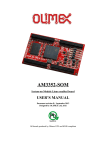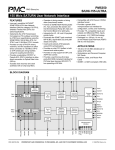Download Quad SPI-3 to SPI-4 Link Layer Bridge IP User`s Guide
Transcript
ispLever CORE TM Quad SPI-3 to SPI-4 Link Layer Bridge Core User’s Guide October 2005 ipug29_02.0 Quad SPI-3 to SPI-4 Link Layer Bridge Core User’s Guide Lattice Semiconductor Introduction Lattice’s Quad SPI-3 (System Packet Interface Level 3) to SPI-4 (System Packet Interface Level 4) Bridge is an IP core which serves as a bridge between one SPI-4 and one to four SPI-3 links. Lattice’s Quad SPI-3 to SPI-4 Bridge core is a core developed in conjunction with the Lattice ORCA® ORSPI4 FPSC to provide a full solution. For more information on these and other Lattice products, refer to the Lattice web site at www.latticesemi.com. This user’s guide explains the functionality of the Quad SPI-3 to SPI-4 Bridge core and how it can be implemented to provide a full SPI-3 to SPI-4 bridging solution. It also explains how to achieve the maximum level of performance. The Quad SPI-3 to SPI-4 Bridge core comes with the documentation and the files listed below: • Data sheet • Lattice gate level netlist • ModelSim simulation models and test benches available for free evaluation • Core instantiation template Features • Quad full-featured SPI-3 LINK Interfaces as defined by the OIF specifications • Supports full clock rates for SPI-3 core: 104MHz • Each SPI-3 LINK can support up to eight ports • Seamless integration with the SPI-4.2 Embedded core in the ORSPI4 FPSC • 10Gbps aggregate throughput • Parameterizable number of SPI-3 LINK interfaces (1 to 4) • Parameterizable SPI-3 BYTE_MODE or PKT_MODE selection • Configurable through MicroProcessor Interface (MPI) ORCA4 System Bus • Programmable parity type on SPI-3 bus. Default is ODD. General Description The Quad SPI-3 to SPI-4 Bridge Intellectual Property (IP) Core targets the programmable array section of the ORCA ORSPI4 FPSC and provides a bridging function between one to four SPI-3 links and a SPI-4 link. The ORSPI4 is an FPSC built on the Series 4 re-configurable embedded System-on-a-Chip (SoC) architecture and intended for high-speed data transmission. The SPI-4.2 interface block provides a 10Gbps physical to Link Layer interfaces in conformance to the OIF-SPI4-02.0 specification and bi-directional interfaces with an aggregate bandwidth of 13.6Gbps. SPI-4 is an interface for packet and cell transfer between a Physical Layer (PHY) device and a Link Layer device, for applications such as OC-192 ATM and Packet over SONET/SDH (POS), as well as 10Gbps Ethernet applications. The SPI-3 interface defines the interface between Physical Layer and Link Layer devices, and can be used to implement several packet-based protocols. The SPI-3 interface supports clock transfer rates of 104MHz and an aggregate bit rate of 2.5Gbps with a 32-bit wide bus. The Quad SPI-3 to SPI-4 Bridge IP core is provided with implementation scripts, test benches and documentation to allow designers to bridge multiple 2.5Gbps ports (SPI-3) to a 10Gbps (SPI-4) pipe. 2 Quad SPI-3 to SPI-4 Link Layer Bridge Core User’s Guide Lattice Semiconductor Quad SPI-3 to SPI-4 Bridge Application Overview The SPI-3 interface (referred to interchangeably as PL-3 or POS-PHY Level 3) is designed to comply with the OIF implementation agreement (OIF-SPI3-01.0). The bridge design implements an SPI-3 LINK layer. The primary application is to bridge a network processor with an SPI-4 interface to multiple 2.5Gb framers, each with an SPI-3 interface as shown in Figure 1. Figure 1. Application of Quad SPI-3 to SPI-4 Bridge ORSPI4 2.5G Optical I/F 2.5G Framer SPI-3 Link Layer 0 2.5G Optical I/F 2.5G Framer SPI-3 Link Layer 1 2.5G Optical I/F 2.5G Framer SPI-3 Link Layer 2 2.5G Optical I/F 2.5G Framer SPI-3 Link Layer 3 SPI-4 I/F Line Card SPI-4 Network Processor Element (NPE) Functional Description Figure 2. SPI-3 to SPI-4 Link Layer Bridge Solution Simplified Block Diagram Embedded ASB Section IP in FPGA Section SPI-3 Receive Interface and DPRAM Write Control RFCLK RVAL RENB RDAT[31:0] RMOD[1:0] RPRTY REOP RSOP RERR RSX Polling Sequence Controller TADR[2:0] Polling Satus Table PTPA DTPA[7:0] STPA SPIA_TX32CLKx Tx DPRAM Tx_D[38:0] WD_CNT_RST Tx_WE Tx_Port[7:0] Tx_A[2:0] FIFO_FULL ATREF_CLK Port Write Sequence Logic Tx_PortID[7:0] Tx_Bkp Tx_Stat[1:0] No connect SPIA_RX32_CLKx Rx DPRAM Rx_D[39:0] Rx_FIFO_Empty Rx_A[2:0] Rx_RE 0 Rx Port Status Sequencer Rx_Ext_Status_enable Rx_Port_Status[1:0] Rx_FPGA_Port_ID[7:0] Rx_PSS_WE SPI-3 Transmit Interface and DPRAM Read Control No connect Note: SPI-3 interface logic can be replicated up to 4x (quad) for 10G applications. 3 TFCLK TENB TDAT[31:0] TMOD[1:0] TPRTY TSOP TEOP TERR TSX Quad SPI-3 to SPI-4 Link Layer Bridge Core User’s Guide Lattice Semiconductor The major blocks in the Quad SPI-3 to SPI-4 Bridge core are shown in Figure 2. Detailed descriptions of these blocks follow. Transmit Section The transmit section can be divided into the following functional blocks: • TX SPI-3 Interface • Polling Sequence Controller and Polling Status Table TX SPI-3 Interface This block is controlled by a state machine which reads the virtual FIFOs within the DPRAMs based on the settings in the “DPRAM Read Provisioning Registers.” The circuit operates differently based on the polling method selected, so the two possible modes of operation will be discussed separately. If STPA (selected-PHY transmit packet available) polling has been configured, then the TX block is controlled by a state machine which alternates between two high level states. The first is a polling state which checks to see if any virtual FIFOs are empty. Also during this state it polls all PHY Layer FIFOs to determine which are below the programmed threshold. The second high level state is a read state where the circuit reads data from each virtual FIFO in the DPRAM and transmits it to the PHY Layer device. Whenever a DPRAM FIFO contains data, it is read until a pre-selected (programmable) number of bytes have been read or until the FIFO is empty. The “DPRAM Read Provisioning Registers” have no effect when STPA has been selected. If either DTPA or PTPA (direct transmit packet available or polled-PHY transmit packet available) are selected, then the state machine in the TX interface circuit continuously cycles through the DPRAM virtual FIFOs, reading each one in turn to determine if DTPA or PTPA indicate that the present port can accept data on the SPI-3. Once the state machine begins reading a virtual FIFO, it continues reading until the virtual FIFO either goes empty or until a pre-selected (programmable) number of bytes have been read. The order in which the virtual FIFOs are selected to be read by the state machine is user programmable via the “DPRAM Read Provisioning Registers.” The provisioning registers will reset on power-up to sequentially read all virtual FIFOs which have been configured. If the user wishes to turn off particular ports, then the eight registers should be written with a pattern which allocates read cycles to the remaining ports only. For example, if four FIFOs have been configured, and only ports 0 and 1 are to be enabled, then the eight registers should be programmed with a pattern of 0, 1, 0, 1, 0, 1, 0, 1 (0x00 written to register 0x8003, 0x01 written to register 0x8004, 0x00 written to register 0x8005, etc.). When DTPA or PTPA have been selected, then data throughput efficiency for a particular port is determined mainly by the SPI-3 burst size, since a virtual FIFO will be read until it either goes empty, or until the SPI-3 burst size is reached. The state machine will allocate a minimum of five clock cycles to each port as it sequentially reads each virtual FIFO. Therefore any ports which have no data will “waste” five clock cycles each time through the rotation. However, for the maximum burst size of 256 bytes, each FIFO containing data may be read for up to 64 clock cycles, so ports containing data are automatically allotted more bandwidth. By setting the provisioning registers to disable unused ports, the five clock cycles which would be wasted are allocated back to the ports in use. For both modes of operation (STPA and DTPA/PTPA) when an in-band port number is read from the DPRAM (indicated by Rx_D[39] being high), then the TX SPI-3 Interface circuit will transmit the port number on the SPI-3 interface and set the TSX signal. In addition, before transmitting the port number on the SPI-3 interface, the circuit will force the next two most significant bits above the port number to zeros. For example, if the core is configured for eight ports per SPI-3 interface, then the port number which is transmitted on the SPI-3 in TDAT will use bits[2:0] to identify one of eight ports, and the circuit will force bits [4:3] to zeros. Parity is calculated and set on the TPRTY output during each word of the burst. Parity type may be set to either even or odd and is programmable. This circuit does not use the external access to the RX Port Status Sequencer logic which resides within the FPSC so the Rx_Ext_Status_enable signal is hardwired to 0 to disable the external status interface. 4 Quad SPI-3 to SPI-4 Link Layer Bridge Core User’s Guide Lattice Semiconductor Polling Sequence Controller and Polling Status Table Block Byte-Level Mode: Either the DTPA (direct transmit packet available) or STPA (selected-PHY transmit packet available) signals may be used to obtain FIFO status information from the PHY device when performing byte-level transfers between the PHY and Link layers. The DTPA bus provides direct status indications for the ports in the PHY device. There is one signal on the DTPA bus for each FIFO in the PHY. Each DTPA signal transitions high when a predefined minimum number of bytes are available in the corresponding PHY Layer FIFO. The threshold at which DTPA transitions high must be set in the PHY Layer device. STPA may also be used to obtain FIFO status from the PHY device in byte-level transfers. STPA transitions high when a predefined minimum number of bytes are available in the transmit PHY Layer FIFO specified by the in-band address on TDAT. Once high, STPA indicates the transmit FIFO is not full. When STPA transitions low, it indicates that the transmit FIFO is full or near full. The STPA signal is used to populate the Polling Status Table which keeps track of the latest status of each port which has been received from the PHY device. When STPA is implemented, the Link Layer device will poll the PHY Layer FIFO before it can send data to that FIFO. The Link Layer device will send a port number to the PHY device on TDAT, and then wait for the status of the FIFO to be returned on STPA. Also, the Link Layer TX Interface circuit will poll the corresponding virtual FIFO in the DPRAM to see if it contains data. When there is data in the DPRAM for a particular port number and the corresponding PHY Layer FIFO has available space, then the TX Interface circuit will send a burst of data to the PHY Layer. The TX Interface circuit will use a round-robin scheme to cycle through all ports. If DTPA has been implemented, then polling of PHY Layer FIFOs using in-band port numbers is not needed, and therefore the polling actions described in the previous paragraph will not be implemented. In this case the Link device will continuously read the DPRAM FIFOs and send data in direct response to the status received on the DTPA signals. Packet Level Mode: The PTPA (Polled-PHY Transmit Packet Available) signal transitions high when a predefined minimum number of bytes are available in the polled transmit FIFO in the PHY device. Once high, PTPA indicates that the transmit FIFO is not full. When PTPA transitions low, it indicates that the transmit FIFO is full or near full. PTPA allows the polling of the PHY selected by the TADR address bus. The port that PTPA reports is updated on the following rising edge of TFCLK after the PHY address on TADR is sampled by the PHY device. The address is driven from a counter in the Polling Sequence Controller block. This counter sequences through all of the PHY port numbers. The Link Layer Bridge device will automatically update its internal Polling Status Table using PTPA in response to the PHY numbers sent to the PHY on TADR. The number of PHYs must be assigned using the NUM_PORTS parameter. Any data received from the SPI-4 that does not have a valid PHY number will be read from the Link device’s FIFO and transmitted on the SPI-3. This prevents errors in the port or PHY numbers from the SPI-4 from causing a blocking condition in the Link device Receive Section The receive section bridges up to four SPI-3 links to a single SPI-4. As shown in Figure 2, the receive section consists of one block, the RX SPI-3 Interface. This block interfaces one SPI-3 link to as many as eight RX direction virtual FIFOs within a DPRAM. There may be from one to four RX SPI-3 Interface blocks provisioned depending on the desired number of SPI-3 links. This block receives data (32-bit bus) from the PHY device along with RSX, REOP, RSOP, RERR and RMOD bits. All bits except RSX are written into the DPRAM. It supports either even or odd parity checking (user programmable) over the RX data. It extracts the port address on RDAT[7:0] when indicated by the RSX input being active and uses the port number to select from up to eight virtual FIFOs. The interface conforms to the OIF-SPI3-01.0 specification. The port number will be indicated by the RSX signal at the beginning of a burst of data from the PHY Layer device. For the duration of the burst, the RX SPI-3 Interface circuit writes the data into the virtual FIFO, selected by the port number, by setting the Tx_Port[7:0] value, and it holds the RENB signal low as long as the amount of data in the selected virtual FIFO does not exceed the threshold. For the interface to work correctly, the threshold on the 5 Quad SPI-3 to SPI-4 Link Layer Bridge Core User’s Guide Lattice Semiconductor DPRAM should be programmed to the 3/4 full + 1 level by setting the FIFO_FULL_TYPE_SEL bit in the FPSC high. When a burst of data is written into a DPRAM, the Tx_Port signals into the ASB are set to the port number. In order to uniquely identify data associated with different SPI-3 interfaces which may have the same port number (for example, if port 1 is used on interface 0 and port 1 is also used on interface 1), the RX Interface circuit will set at most up to two bits of the Tx_Port value to indicate the SPI-3 interface number. The bits which the circuit automatically sets will always be the next most significant bits following the port number. For example, if the core is configured for 4 SPI-3 interfaces and 4 ports per interface, then Tx_Port[1:0] will identify which of four port numbers the data is associated with, and Tx_Port[3:2] will be set by the circuit to indicate the SPI-3 interface number. This feature is hardcoded in the circuit and cannot be disabled. Design Parameters Table 1. Parameters No. Parameter Choice Default 1, 2, 3, 4 4 32, 64, 128, 256 32 1, 2, 4, 8 4 DTPA Selected Yes/No Yes PTPA Selected Yes/No No STPA Selected Yes/No No 1 Number of SPI-3 Interfaces 2 Burst Size 3 Number of Ports per Interface 4 5 6 Note: Only one of the polling methods (DTPA, STPA, or PTPA) may be selected at one time. Register Interface Description A bank of registers are implemented to manage various programmable control functions and store various error and status signals. These registers are controlled by a register interface that is compatible with the ORCA System Bus interface. The ORCA SYSBUS slave interface is instantiated to control the core registers. The external FPGA control interface is compatible with a Motorola MPC860 Power PC interface. The core maintains an 8-bit implementation of the system bus. Details of the operation of the system bus are available in Lattice technical note TN1017, ORCA Series 4 MPI/System Bus, at www.latticesemi.com. Table 2. Register Descriptions Register Name Register Address Description ID/Version Register 0x8000 ID/Version Number of Core Parity Control Register 0x8001 Selects Odd or Even parity on SPI-3 interface Transmit Parity Error Register 0x8002 Indicates parity error on a SPI-3 interface DPRAM Read Provisioning Register 0 0x8003 Selects Virtual FIFO to be read during cycle 1 of 8 DPRAM Read Provisioning Register 1 0x8004 Selects Virtual FIFO to be read during cycle 2 of 8 DPRAM Read Provisioning Register 2 0x8005 Selects Virtual FIFO to be read during cycle 3 of 8 DPRAM Read Provisioning Register 3 0x8006 Selects Virtual FIFO to be read during cycle 4 of 8 DPRAM Read Provisioning Register 4 0x8007 Selects Virtual FIFO to be read during cycle 5 of 8 DPRAM Read Provisioning Register 5 0x8008 Selects Virtual FIFO to be read during cycle 6 of 8 DPRAM Read Provisioning Register 6 0x8009 Selects Virtual FIFO to be read during cycle 7 of 8 DPRAM Read Provisioning Register 7 0x800A Selects Virtual FIFO to be read during cycle 8 of 8 6 Quad SPI-3 to SPI-4 Link Layer Bridge Core User’s Guide Lattice Semiconductor Table 3. Register Map for Quad SPI-3 to SPI-4 LINK Layer Bridge Core Address: 0x8000 D7 Name: ID/Version Register D6 D5 D4 D3 D2 D1 D0 ID/VER Default value: 0x01 Mode: Read Only Description: ID/VER The ID and version number of this core. Address: 0x8001 Name: Parity Control Register D7 D6 — D5 D4 D3 — Default value: 0x03 D2 D1 D0 — RX_PAR TX_PAR Mode: Read/Write Description: TX_PAR When high, odd parity is supported on the SPI-3 transmit interfaces. RX_PAR When high, odd parity is supported on the SPI-3 receive interfaces. Address: 0x8002 Name: Transmit Parity Error Register D7 D6 — D5 D4 — Default value: n/a D3 D2 D1 D0 PERR_3 PERR_2 PERR_1 PERR_0 Mode: Clear on Read Description: PERR_N Detection of a parity error on any port on interface N sets this bit. This bit clears upon reading. Address: 0x8003 D7 Name: DPRAM Read Provisioning Register 0 D6 — D5 D4 D3 D2 — D1 D0 RSEL_0 Default value: Depends on configuration. See Functional Description section. Mode: Read/Write Description: RSEL_0 Selects virtual FIFO to be read during cycle 1 of 8. Address: 0x8004 D7 — Name: DPRAM Read Provisioning Register 1 D6 D5 D4 D3 — Default value: Depends on configuration. See Functional Description section. D1 RSEL_1 Mode: Read/Write Description: RSEL_1 D2 Selects virtual FIFO to be read during cycle 2 of 8. 7 D0 Quad SPI-3 to SPI-4 Link Layer Bridge Core User’s Guide Lattice Semiconductor Table 3. Register Map for Quad SPI-3 to SPI-4 LINK Layer Bridge Core (Continued) Address: 0x8005 D7 Name: DPRAM Read Provisioning Register 2 D6 — D5 D4 D3 D2 — D1 D0 RSEL_2 Default value: Depends on configuration. See Functional Description section. Mode: Read/Write Description: RSEL_2 Selects virtual FIFO to be read during cycle 3 of 8. Address: 0x8006 Name: DPRAM Read Provisioning Register 3 D7 D6 — D5 D4 D3 D2 — D1 D0 RSEL_3 Default value: Depends on configuration. See Functional Description section. Description: RSEL_3 Selects virtual FIFO to be read during cycle 4 of 8. Address: 0x8007 Name: DPRAM Read Provisioning Register 4 D7 D6 — D5 D4 D3 D2 — D1 D0 RSEL_4 Default value: Depends on configuration. See Functional Description section. Mode: Read/Write Description: RSEL_4 Selects virtual FIFO to be read during cycle 5 of 8. Address: 0x8008 Name: DPRAM Read Provisioning Register 5 D7 D6 — D5 D4 D3 D2 — D1 D0 RSEL_5 Default value: Depends on configuration. See Functional Description section. Mode: Read/Write Description: RSEL_5 Selects virtual FIFO to be read during cycle 6 of 8. Address: 0x8009 Name: DPRAM Read Provisioning Register 6 D7 — D6 D5 D4 D3 — Default value: Depends on configuration. See Functional Description section. D1 RSEL_6 Mode: Read/Write Description: RSEL_6 D2 Selects virtual FIFO to be read during cycle 7 of 8. 8 D0 Quad SPI-3 to SPI-4 Link Layer Bridge Core User’s Guide Lattice Semiconductor Table 3. Register Map for Quad SPI-3 to SPI-4 LINK Layer Bridge Core (Continued) Address: 0x800A D7 — Name: DPRAM Read Provisioning Register 7 D6 D5 D4 D3 — Default value: Depends on configuration. See Functional Description section. D1 RSEL_7 Mode: Read/Write Description: RSEL_7 D2 Selects virtual FIFO to be read during cycle 8 of 8. 9 D0 Quad SPI-3 to SPI-4 Link Layer Bridge Core User’s Guide Lattice Semiconductor Signal Descriptions Table 4. Signal Definitions for Quad SPI-3 to SPI-4 Link Bridge Solution I/O Signal Name Direction Description SPI-3 Signals1 RFCLK Input SPI-3 Interface Clock TFCLK Input SPI-3 Interface Clock (from Transmit FIFO) RERR Input Receive Error Indicator RENB Output Receive Read Enable RVAL Input Receive Data Valid RDAT [31:0] Input Receive Packet Data Bus RMOD [1:0] Input Receive Word Modulo RPRTY Input Receive Bus Parity RSX Input Receive Start of Transfer RSOP Input Receive Start of Packet Input Receive End of Packet REOP TSX Output Transmit Start of Transfer TENB Output Transmit Write Enable TERR Output Transmit Error Indicator TSOP Output Transmit Start of Packet TEOP Output Transmit End of Packet TDAT [31:0] Output Transmit Packet Data Bus TMOD [1:0] Output Transmit Word Modulo TPRTY Output Transmit Bus Parity TADR [2:0] Output Transmit PHY Address Bus DTPA [7:0] Input Direct Transmit Packet Available STPA Input Selected PHY Transmit Packet Available PTPA Input Polled PHY Transmit Packet Available Input LVDS signals for SPI-4.2 RXA Input LVDS signal for RXA Control Input Differential RXA Data clock signal SPI-4 Signals2 ARDAT[15:0]P ARDAT[15:0]N ARCTLP ARCTLN ARDCLKP ARDCLKN ARSTAT[1:0]P ARSTAT[1:0]N ARSCLKP ARSCLKN Output LVDS Status Output Output LVDS Status Output Clock RSTAT[1:0]A Output LVTTL Status Output RSCLKA Output LVTTL Status Clock Output Output LVDS signals for SPI-4.2 TXA Output Transmit Control for SpiSPI-4.2 TXA ATDAT[15:0]P ATDAT[15:0]N ATCTLP ATCTLN 10 Quad SPI-3 to SPI-4 Link Layer Bridge Core User’s Guide Lattice Semiconductor Table 4. Signal Definitions for Quad SPI-3 to SPI-4 Link Bridge Solution I/O (Continued) Signal Name ATDCLKP Direction Output ATDCLKN ATSTAT[1:0]P Description Differential TXA clock signal Input LVDS Status Input Input LVDS Status Input clock TSTAT[1:0]A Input LVTTL Status Input TSCLKA Input LVTTL Status Clock Input ATSTAT[1:0]N ATSCLKP ATSCLKN ORSPI4 Embedded Core Control, Global I/O and FPGA Configuration I/O3 1. The signals listed here are required for a single SPI-3 interface. The signals should be replicated for each additional SPI-3 Interface instantiation. 2. The signals listed here are required for the SPI-4 interface A (signal names are prefaced with the letter “A”). Please refer to the ORSPI4 Data Sheet for additional information on configuring the SPI-4 interface for specific applications. 3. Please refer to the ORCA Series 4 FPGA Data Sheet and the ORSPI4 Data Sheet for information on the various configuration options. Table 5. Signal Definitions for Quad SPI-3 to SPI-4 Link Bridge Solution - FPGA/Embedded ASB Interface (Internal to ORSPI4 Device) Signal Name FPGA Direction Description Transmit Interface Signals SPIA_RX32_CLKx Output Read Clock to DPRAM Bank 0 RX_D[31:0] Input Read Data from DPRAM Bank 0 RX_D[32] Input SOP Indicator from DPRAM Bank 0 RX_D[33] Input EOP Indicator from DPRAM Bank 0 RX_D[37:34] Input Byte Valid Indicator from DPRAM Bank 0 RX_D[38] Input Error Indication for Read Data RX_D[39] Input Port ID Indicator (RSX in SPI-3) RX_FIFO_EMPTY Input FIFO Empty Flag from DPRAM Bank 0 RX_A[2:0] Output Read Address to DRPAM Bank 0 RX_RE Output Read Enable to DPRAM Bank 0 RX_PSS_CLK Output Write Clock to PSS Memory RX_EXT_STATUS_EN Output Indicates Valid Status RX_PORT_STATUS[1:0] Output 2-bit status for Port specified by TX_Port_ID RX_FPGA_PORTID[7:0] Output Address of Port for which Status is provided RX_PSS_WE Output Write Enable to PSS Memory Transmit Status Signals Receive Status Signals ATREFCLK TX_SPI_CLK Input Output SPI-4 Transmit Reference Clock SPI-3 Transmit Clock TX_PORT_ID[7:0] Input Address of Port for which Status is provided TX_BKP Input SPI-4 Backpressure to FPGA TX_STAT[1:0] Input Status of Port specified by TX_PORT_ID Receive Interface Signals SPIA_TX32_CLKx Output Write Clock to DPRAM Bank 0 TX_D[31:0] Output Write Data to DPRAM Bank 0 11 Quad SPI-3 to SPI-4 Link Layer Bridge Core User’s Guide Lattice Semiconductor Table 5. Signal Definitions for Quad SPI-3 to SPI-4 Link Bridge Solution - FPGA/Embedded ASB Interface (Internal to ORSPI4 Device) (Continued) Signal Name FPGA Direction Description TX_D[32] Output SOP Indicator to DPRAM Bank 0 TX_D[33] Output EOP Indicator to DPRAM Bank 0 TX_D[37:34] Output Byte Valid Indicator to DPRAM Bank 0 TX_D[38] Output Error Indication for Write Data WD_CNT_RST Output WCL Word Count Reset 0 TX_WE Output Write Enable for DPRAM Bank 0 TX_A[2:0] Output Write Address for DPRAM Bank 0 TX_PORT[7:0] Output FIFO_FULL Input Port ID for DPRAM Bank 0 FIFO Full Flag from DPRAM Bank 0 1. The signals listed here are required for a single SPI-3 interface. The signals should be replicated for each additional SPI-3 Interface instantiation. The status signals in both receive and transmit directions between the FPGA and the embedded Application Specific Block (ASB) are not replicated when the core has multiple SPI-3 interfaces. SPI-3 I/O Timing and Electrical Specifications The examples in the following sections are provided to aid in the visualization of the interface operation. Transmit Logical Timing Figure 3 shows transactions on a SPI-3 Transmit interface with two ports. The SPI-3 transmit interface is controlled by the Link Layer device using the TENB signal. All signals must be updated and sampled using the rising edge of the transmit FIFO clock, TFCLK. The PHY Layer device indicates that a FIFO is not full by asserting the appropriate transmit packet available signal DTPA. DTPA remains asserted until the transmit FIFO is almost full. “Almost full” implies that the PHY Layer device can accept, at most, a predefined number of writes after the current write. If DTPA is asserted and the Link Layer device is ready to write a word, it should assert TSX, de-assert TENB and present the port address on the TDAT bus if required. Subsequent data transfers with TENB low are treated as packet data, which is written to the selected FIFO. At any time, if the Link Layer device does not have data to write, it can de-assert TENB. The TSOP and TEOP signals must be appropriately marked at the start and end of packets on the TDAT bus. When DTPA transitions low and it has been sampled, the Link Layer device can write no more than a predefined number of bytes to the selected FIFO. In this particular example, the predefined value is two double-words or eight bytes. In the IP core implementation, if DTPA is high the PHY Layer can accept a complete burst. When the DTPA is deasserted the PHY Layer can accept the burst being transferred but no more. If the Link Layer writes more than that predefined number of words and DTPA remains deasserted throughout, the PHY Layer device should indicate an error condition and ignore additional writes until it asserts DTPA again. 12 Quad SPI-3 to SPI-4 Link Layer Bridge Core User’s Guide Lattice Semiconductor Figure 3. Transactions on the SPI-3 Transmit Interface TFCLK TENB TSOP TEOP TMOD[1:0] TERR TSX TDAT[31:0] 0000 B1-B4 B5-B8 B41-B44 B45-B48 B49-B52 B53-B56 B57 0001 B1-B4 TPRTY STPA DTPA[0] DTPA[1] Figure 4 shows the use of the polling feature of the transmit interface. For comparison purposes, the “direct transmit packet available” signals for the example ports are provided in the diagram. The status of a given PHY port may be determined by setting the polling address TADR bus to the port address. The “polled transmit packet available” signal PTPA is updated with the transmit FIFO status in a pipelined manner. The Link Layer device is not restricted in its polling order. The “selected transmit packet available” STPA signal allows monitoring of the selected PHY status and halting of the data transfer once the FIFO is full. The PTPA signal allows polling other PHY’s at any time, including while a data transfer is in progress. Figure 4. Packet Level Transmit Polling TFCLK TADR[n:0] PTPA P0 P1 P2 P0 P3 P1 P2 P0 P3 P1 P3 P2 P0 P0 P1 P1 P2 P2 P0 P3 P1 P2 P3 DTPA[0] DTPA[1] DTPA[2] DTPA[3] Transmit Interface AC Timing Table 6. Transmit Interface Timing Symbol Description Min. Max. Units TFCLK Frequency — 104 MHz TFCLK Duty Cycle 40 60 % tStenb TENB Set-up time to TFCLK tHtenb TENB Hold time to TFCLK tStdat TDAT[15:0] Set-up time to TFCLK tHtdat TDAT[15:0] Hold time to TFCLK tStprty TDPRTY Set-up time to TFCLK tHtprty TDPRTY Hold time to TFCLK tStsop TSOP Set-up time to TFCLK tHtsop TSOP Hold time to TFCLK tSteop TEOP Set-up time to TFCLK tHteop TEOP Hold time to TFCLK tStmod TMOD Set-up time to TFCLK tHtmod TMOD Hold time to TFCLK 13 2 — ns 0.5 — ns 2 — ns 0.5 — ns 2 — ns 0.5 — ns 2 — ns 0.5 — ns 2 — ns 0.5 — ns 2 — ns 0.5 — ns Quad SPI-3 to SPI-4 Link Layer Bridge Core User’s Guide Lattice Semiconductor Table 6. Transmit Interface Timing (Continued) Symbol Description Min. Max. Units 2 — ns tSterr TERR Set-up time to TFCLK tHterr TERR Hold time to TFCLK 0.5 — ns tStsx TSX Set-up time to TFCLK 2 — ns tHtsx TSX Hold time to TFCLK 0.5 — ns tStadr TADR[4:0] Set-up time to TFCLK 2 — ns tHtadr TADR[4:0] Hold time to TFCLK 0.5 — ns tPdtpa TFCLK High to DTPA Valid 1.5 6 ns tPstpa TFCLK High to STPA Valid 1.5 6 ns tPptpa TFCLK High to PTPA Valid 1.5 6 ns Figure 5. Transmit Physical Timing TFCLK tStenb tHtenb tStdat tHtdat tStprty tHtprty tStsop tHtsop tSteop tHteop tStmod tHtmod tSterr tHterr tStsx tHtsx tStadr tHtadr TENB TDAT[31:0] TPRTY TSOP TEOP TMOD[1:0] TERR TSX TADR[] tPdtpa DTPA[] tPstpa STPA tPptpa PTPA Notes on Transmit Interface I/O Timing: 1. When a set-up time is specified between an input and a clock, the set-up time is the time in nanoseconds from the 1.4V point of the input to the 1.4V point of the clock. 2. When a hold time is specified between an input and a clock, the hold time is the time in nanoseconds from the 1.4V point of the clock to the 1.4V point of the input. 3. Output propagation delay time is the time in nanoseconds from the 1.4V point of the reference signal to the 1.4V point of the output. 4. Maximum output propagation delays are measured with a 30pF load on the outputs. 14 Quad SPI-3 to SPI-4 Link Layer Bridge Core User’s Guide Lattice Semiconductor Receive Logical Timing Figure 6 shows transactions on a SPI-3 Receive interface with two ports. The SPI-3 Receive Interface is controlled by the Link Layer device using the RENB signal. All signals must be updated and sampled using the rising edge of the receive FIFO clock. The RDAT bus, RPRTY, RMOD, RSOP, REOP and RERR signals are valid in cycles for which RVAL is high and RENB was low in the previous cycle. When transferring data, RVAL is asserted and remains high until the internal FIFO of the PHY Layer device is empty or an end of packet is transferred. The RSX signal is valid in the cycle for which RVAL is low and RENB was low in the previous cycle. The PHY informs the Link Layer device of the port address of the selected FIFO by asserting RSX with the port address on the RDAT bus. The Link Layer may pause the Receive Interface at any time by de-asserting the RENB signal. When the selected FIFO is empty, RVAL is de-asserted. In this example, the RVAL is re-asserted, without changing the selected FIFO, transferring the last section of the packet. The end of the packet is indicated with the REOP signal. Thus, the next subsequent FIFO transfer for this port would be the start of the next packet. If an error occurred during the reception of the packet, the RERR would be asserted with REOP. Since another port’s FIFO has sufficient data to initiate a bus transfer, RSX is again asserted with the port address. In this case, an intermediate section of the packet is being transferred. Figure 6. Transactions on the SPI-3 Receive Interface RFCLK RENB RSX RSOP REOP RERR RMOD[1:0] RDAT[31:0] 0000 B1-B4 B5-B8 B9-B12 B41-B44 B45-B48 B52-B55 B56-B57 0001 B21-B25 RPRTY RVAL Figure 7 shows the use of the pause feature of the receive interface. The first transfer is a complete 3-byte packet and the second transfer is the end of a 36-byte packet. The pause allows the Link Layer device to halt data between transfers. In order to handle an end of packet, the Link Layer device may de-assert the RENB signal when it samples REOP active. As shown in the diagram, the Link Layer device pauses the PHY device on the in-band address for two clock cycles. Figure 7. Receive Interface Transactions with Pausing RFCLK RENB RSX RSOP REOP RERR RDAT[7:0] 03 B1 B2 B3 01 RPRTY RVAL 15 B33 B34 B35 B36 Quad SPI-3 to SPI-4 Link Layer Bridge Core User’s Guide Lattice Semiconductor Receive Interface AC Timing Table 7. Receive Interface Timing Min. Max. Units RFCLK Frequency Description — 104 MHz Symbol RFCLK Duty Cycle 40 60 % tSrenb RENB Set-up time to RFCLK 2 — ns tHrenb RENB Hold time to RFCLK 0.5 — ns tPrdat RFCLK High to RDAT Valid 1.5 6 ns tPrprty RFCLK High to RPRTY Valid 1.5 6 ns tPrsop RFCLK High to RSOP Valid 1.5 6 ns tPreop RFCLK High to REOP Valid 1.5 6 ns tPrmod RFCLK High to RMOD Valid 1.5 6 ns tPrerr RFCLK High to RERR Valid 1.5 6 ns tPrval RFCLK High to RVAL Valid 1.5 6 ns tPrsx RFCLK High to RSX Valid 1.5 6 ns Figure 8. Receive Physical Timing RFCLK tSrenb tHrenb RENB tPrdat RDAT[31:0] tPrprty RPRTY tPrmod RMOD tPrsop RSOP tPreop REOP tPrerr RERR tPrval RVAL tPrsx RSX Notes on Receive I/O Timing: 1. When a set-up time is specified between an input and a clock, the set-up time is the time in nanoseconds from the 1.4V point of the input to the 1.4V point of the clock. 2. When a hold time is specified between an input and a clock, the hold time is the time in nanoseconds from the 1.4V point of the clock to the 1.4V point of the input. 3. Output propagation delay time is the time in nanoseconds from the 1.4V point of the reference signal to the 1.4V point of the output. 4. Maximum output propagation delays are measured with a 30pF load on the outputs. 16 Quad SPI-3 to SPI-4 Link Layer Bridge Core User’s Guide Lattice Semiconductor Quad SPI-3 to SPI-4 LINK Layer Bridge Core Design Flow The Quad SPI-3 to SPI-4 Bridge IP Core can be implemented using various methods. The scope of this document covers only the push-button Graphical User Interface (GUI) flow. Figure 9 illustrates the software flow model used when evaluating with the Quad SPI-3 to SPI-4 Bridge core. Figure 9. Lattice IP Core Evaluation Flow Start Install and launch ispLEVER software Obtain desired IP package (download Core Evaluation package or purchase IP package) Protected Simulation Model Install IP package IP Core Netlist Perform functional simulation with the provided core model Synthesize top-level design with the IP black box declaration Place and route the design Run static timing analysis Done Functional Simulation Under ModelSim (PC Platform)1 Once the Quad SPI-3 to SPI-4 Bridge core has been downloaded and unzipped to the designated directory, the core is ready for evaluation. The RTL simulation environment contains a testbench and a simple application that uses the Quad SPI-3 to SPI-4 Bridge design. The application instantiates the Quad SPI-3 to SPI-4 Bridge core, an ORCA ORSPI4 module and an ORCA SYSBUS module. The module name of the application is called “qspi3_link”. The testbench includes a SPI-4 driver, a SPI-4 monitor, an instantiation of the user application and SPI-3 loopback models. In the simulation many packets of varying length generated by the SPI-4 driver are applied to the receive side of the SPI-4 bridge. A loopback is implemented at the SPI-3 interface. The packets received at the SPI-4 transmit interface are checked against the packets sent by the SPI-4 driver. The Quad SPI-3 to SPI-4 Link Layer Bridge design and testbench models have been compiled into the work directories “source\top”, source\sim”, and “eval\test\*”. The Quad SPI-3 to SPI-4 LINK IP, ORCA4, ORSPI4 and SYS1. Note that the pre-compiled ORSPI4 simulation models provided in this IP evaluation package do not work with the OEM version of ModelSim embedded in the ispLEVER® v.3.0 software. The full, licensed version of ModelSim is required to run this simulation. 17 Quad SPI-3 to SPI-4 Link Layer Bridge Core User’s Guide Lattice Semiconductor BUS models have been provided in the directory “lib\modelsim” as zip archives (spi_324l_o4_1_001.zip, orca4_work.zip, orspi4_work.zip and sysbus_work.zip). These files should be unarchived into the directory “lib\modelsim. All these work directories have to be refreshed before simulation can be run. A simulation script file is provided in the “eval\simulation\scripts” directory for RTL simulation. The script file run_vsim.bat (for PC) uses the precompiled models provided with this package. It calls the “run_qspi3_nocore.plx” perl script in the same “scripts” directory. The paths to “MODELTECH” in the script file should be set to the appropriate MTI Modelsim version value for the local system. The simulation is run by executing “scripts\run_vsim.bat” from the “eval\modelsim” directory. A successful simulation is achieved when the “TEST PASSED” message is displayed at the end of the simulation. For more information on how to use ModelSim, please refer to the ModelSim User’s Manual. Core Implementation Lattice’s Quad SPI-3 to SPI-4 Link Layer Bridge evaluation package includes a Quad SPI-3 to SPI-4 Link Layer Bridge user application and scripts for synthesizing, mapping and routing the Quad SPI-3 to SPI-4 Link Layer Bridge IP solution. The Quad SPI-3 to SPI-4 Link Layer Bridge evaluation package includes the following components: • Basic Quad SPI-3 to SPI-4 Link Layer Bridge IP core; • Verilog module that instantiates the ORSPI4 component and the ORCA4 SYSBUS with User Slave component, providing a Motorola Power PC interface to the IP core’s register interface, as well as registers in the ORSPI4 embedded core; This evaluation package is illustrated in Figure 10. The following Verilog files are provided: • qspi3_link_params.v for the Quad SPI-3 to SPI-4 Link Layer Bridge core and top level parameters (Note: this file and all IP parameter files must not be modified in any way. If this file is modified, this IP core may not run at specification); • spi_324l_o4_1_001.v for the Quad SPI-3 to SPI-4 Link Layer Bridge core; • mycore.v for the ORSPI4 module; • sysbus_fpsc.v for the SYSBUS module; • rfclk_hpll_bo.v for PLL; • rfclk_pll_bo.v for PLL; • fpga_io.v for IO SPI3 buffers; • orspi.v for “qspi3_link” top-level module that ties all the application components together. Note that the Quad SPI-3 to SPI-4 Link Layer Bridge Core is delivered as a gate-level netlist (spi_324l_o4_1_001.ngo). Users can compile the entire design shown in Figure 10 to realize a turnkey solution, or instantiate the Quad SPI-3 to SPI-4 Link Layer Bridge Core as a block box together with any of the other blocks shown and/or their own designs, to realize a unique system-level project solution. Users may use orspi.v as a template for their own application. Implementing a design in an ORSPI4 device requires the ispLEVER software and an ORSPI4 FPSC Design Kit. For more information, please contact your local Lattice Semiconductor sales representative or visit the Lattice website at www.latticesemi.com. 18 Quad SPI-3 to SPI-4 Link Layer Bridge Core User’s Guide Lattice Semiconductor Figure 10. Quad SPI-3 to SPI-4 Link Layer Bridge Top-Level Application ORCA 4 sysBUS Model PLL Quad SPI-3 to SPI-4 Link Layer Bridge Core ORSPI4 Model Black Box Consideration Since the core is delivered as a gate-level netlist, the synthesis software will not re-synthesize the internal nets of the core. For more information regarding Synplify’s black box declaration, refer to the Instantiating Black Boxes in Verilog section of the Synplify Reference Manual. Synthesis The following sections provide procedures for synthesizing the Quad SPI-3 to SPI-4 Link Layer Bridge Core IP solution with the Synplicity Synplify and LeonardoSpectrum synthesis tools, which are included in the Lattice ispLEVER software. These procedures generate an EDIF netlist containing the Quad SPI-3 to SPI-4 Link Layer Bridge core as a black box. Synthesis Using Synplicity’s Synplify To synthesize the Quad SPI-3 to SPI-4 Link Layer Bridge solution Synplicity’s Synplify in one step, go to the directory “eval\synthesis\synplicity” and enter “run_syn.bat” (for PC). A top-level EDIF for the application will be produced. Users may use run_syn.bat as a guide and template if they are creating their own unique system-level project solution. The following step-by-step procedure may also be executed. Note that the step-by-step flow results vary from those obtained with the scripted flow due to possible small differences in options between both flows. 1. Create a new working directory for synthesis. 2. Launch the Synplify synthesis tool. 3. Start a new project and add the specified files in the following order: source/synplicity /orca4_synplify.v source/top/qspi3_link_params.v source/synplicity/rfclk_pll_bo.v source/synplicity/rfclk_hpll_bo.v source/synplicity/mycore.v source/synplicity/sysbus_fpsc.v source/top/spi_324l_o4_1_001.v source/top/fpga_io.v source/top/orspi.v 4. In the Implementation Options select the ORCA Series 4 technology, the O4E06 part, speed grade -2 and package BA352. Note that these options are acceptable since synthesis targets the Series 4-based FPGA array of the device. 5. Specify an EDIF netlist filename and EDIF netlist output location in the Implementation Options. This top-level EDIF netlist will be used during Place and Route. 19 Quad SPI-3 to SPI-4 Link Layer Bridge Core User’s Guide Lattice Semiconductor 6. In the Implementation Options, set the following: – Fanout guide: 1000 – Enable FSM Compiler – Enable Resource Sharing – Set the global frequency constraint to 104MHz. 7. Select run. Synthesis Using LeonardoSpectrum To synthesize the Quad SPI-3 to SPI-4 Link Layer Bridge solution LeonardoSpectrum in one step, go to the directory “eval\synthesis\ exemplar” and enter “run_syn.bat” (for PC). A top-level EDIF for the application will be produced. Users may use run_syn.bat as a guide and template if they are creating their own unique system-level project solution. The following step-by-step procedure may also be executed. Note that the step-by step flow results vary from those obtained with the scripted flow due to possible small differences in options between both flows. The step-by-step procedure provided below describes how to run synthesis using LeonardoSpectrum. 1. Create a new working directory for synthesis. 2. Launch the LeonardoSpectrum synthesis tool. 3. Start a new project and select Lattice device technology ORCA-4E. 4. Select Input tab, set the Working Directory path pointed to the source directory. 5. Open the specified files in the following order: source/ exemplar/orca4_leonardo.v source/top/qspi3_link_params.v source/ exemplar/rfclk_pll_bo.v source/ exemplar/rfclk_hpll_bo.v source/ exemplar/mycore.v source/ exemplar/sysbus_fpsc.v source/top/spi_324l_o4_1_001.v source/top/fpga_io.v source/top/orspi.v 6. Select orspi.v, use the right click button on your mouse, and choose from the list “Make orspi.v Top of the Design” 7. In the Constraints tab, set Clock Frequency as 104MHz. 8. Set the Synthesis Directory, created in step 1, as the path where you would like to save the output netlist. 9. Specify an EDIF netlist filename for the output file. This top-level EDIF netlist will be used during Place and Route. 10. Select Run Flow Place and Route Once the EDIF netlist is generated, the next step is to map, place and route the design. The step-by-step procedure provided below explains how to run an EDIF based flow through place and route using ispLEVER Project Navigator. 20 Quad SPI-3 to SPI-4 Link Layer Bridge Core User’s Guide Lattice Semiconductor Once the EDIF netlist is generated, import the EDIF into the Project Navigator. The ispLEVER software automatically detects the provided EDIF netlist of the instantiated IP core in the design. The step-by-step procedure provided below describes how to perform Place and Route in ispLEVER for an ORCA device: 1. Create a new working directory for Place and Route. 2. Start a new project, assign a project name and select the project type as EDIF. 3. Select the ORSPI4 (or ORSPII if that is the option available) target device, with -2 speed grade and the 1036 package. 4. Copy the following files to the Place and Route working directory: a) eval\ngo\spi_324l_o4_1_001.ngo b) eval\prf\exemplar\ qspi3_link.prf (with the LeonardoSpectrum EDIF) eval\prf \synplicity\qspi3_link.prf (with the Synplify EDIF) c) The top-level EDIF netlist generated from running synthesis (with Synplify or Leonardo) 5. Rename the qspi3_link.prf file (in step 4) to match the project name. For example, if the project name is “demo”, then the .prf file must be renamed to demo.prf. The preference file name must match that of the project name. 6. Import the EDIF netlist into the project. 7. In the ispLEVER Project Navigator, select Tools->Timing Checkpoint Options. The Timing Checkpoint Options window will pop-up. In both Checkpoint Options, select Continue. 8. In the ispLEVER Project Navigator, highlight Place and Route Design, with a right mouse click select Properties. Set the following properties: – Routing Passes: 10 for Synplify and LeonardoSpectrum EDIF – Placement Iterations: 1 – Placement Save Best Run: 1 – Placement Iteration Start Point: 1 – Routing Resource Optimization: 0 – Routing Delay Reduction Passes: 1 – Placement Effort Level: 5 All other options remain at their default values. 9. Select the Place and Route Trace Report in the project navigator to execute Place and Route and generate a timing report for ORCA. 10. Highlight Place and Route TRACE Report, with a right mouse click and select Force One Level. A new timing report is generated. Note that it is possible that timing results will change under different versions of synthesis tools or different releases of ispLEVER. If this is the case, multiple placement iteration would need to be run to find the one with 0 timing errors. Multiple placement iterations are run by increasing the “Placement Iterations” value. Reference Information The SPI-3 LINK interfaces in the Quad SPI-3 to SPI-4 Bridge IP core solution are compliant with the standard OIFSPI3-01.0. A complete description of this standard is given in the specification document. • Optical Internetworking Forum (OIF). System Packet Interface Level 3 (SPI-3): OC-48 System Interface for Physical and Link Layer Devices. OIF-SPI3-01.0. A complete description of the SPI-4 standard is given in the specification document 21 Quad SPI-3 to SPI-4 Link Layer Bridge Core User’s Guide Lattice Semiconductor • Optical Internetworking Forum (OIF). System Packet Interface Level 4 (SPI-4) Phase 2: OC-192 System Interface for Physical and Link Layer Devices. OIF-SPI4-02.0 Additional information on implementing this solution is contained in the following documents: • ORCA ORSPI4 FPSC Data Sheet • ORCA Series 4 FPGAs Data Sheet • Lattice technical note number TN1017, ORCA Series 4 MPI/System Bus These documents are available on the Lattice web site at www.latticesemi.com. Technical Support Assistance Hotline: 1-800-LATTICE (North America) +1-408-826-6002 (Outside North America) e-mail: [email protected] Internet: www.latticesemi.com 22 Quad SPI-3 to SPI-4 Link Layer Bridge Core User’s Guide Lattice Semiconductor Appendix for ORCA Series 4 ORSPI4 FPSC Table 8. Programmable Core Performance and Utilization1 Parameters Configuration PFUs Block RAM PLL LUTs fMAX Interfaces Ports Burst Size Polling 001 222 0 4 754 104MHz SPI-3 ref clk 4 4 256 DTPA 1. Results are generated with ispLEVER® v.4.0 targeting ORSPI4, BS-2FE1036C. When using this IP core in a different density, package, speed or grade within the ORCA 4 family, performance may vary. Supplied Netlist Configurations The Ordering Part Number (OPN) for all configurations of this core is SPI-324L-O4-N1. You can use the IPexpress™ software tool to help generate new configurations of this IP core. IPexpress is the Lattice IP configuration utility, and is included as a standard feature of the ispLEVER® design tools. Details regarding the usage of IPexpress can be found in the IPexpress and ispLEVER help system. For more information on the ispLEVER design tools, visit the Lattice web site at: www.latticesemi.com/software. 23 Mouser Electronics Authorized Distributor Click to View Pricing, Inventory, Delivery & Lifecycle Information: Lattice: SPI-324L-O4-N1 SPI-324P-O4-N1













































